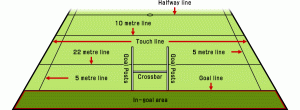Basic rugby rules
For someone new to the game, it can be quite tasking trying to keep track of the play –the game can seem a little complicated for the uninitiated – this is, in no small part to a plethora of rules that are often confusing.
Whether as a player aiming to reach their pinnacle or an enthusiastic fan, it’s essential to understand the basic rules governing this game.
So, in this article, we’ll run through the most basic of the rules and hopefully, you’d begin to appreciate the game more.
The aim of the game
 During a game of rugby, there are 15 players a-side on the field at every moment; with each team playing to score more points than the other side.
During a game of rugby, there are 15 players a-side on the field at every moment; with each team playing to score more points than the other side.
A player might run with the ball, pass it backward, kick it, move it sideways, but never passes it forward in the direction of the opponent’s goal.
Three ways a team can score points include:
- Score a try – a try is scored worth 5 points when a team ground the ball in the opponent’s goal area.
- A conversion – a team, is awarded a place kick after scoring a try. If the kick sails through the crossbar additional 2 points are awarded them.
- A penalty kick – if a player commits a serious infringement, a penalty kick is awarded, and 3 points awarded when successful.
Assuming at the end of a game both teams are tied on points, it’s a draw. However, an extra time is awarded in certain matches like knockout games where a clear winner is needed.
Duration
A game of rugby lasts for 80 minutes with 2 halves of 40 minutes and a 10 minutes break between the halves.
Kick-offs
Before, kick off, the referee tosses a coin between both captains to decide which team will attack first. The game is then started, by a place or drop kick.
The ball
Unlike a soccer ball that’s round, a rugby ball is flat with curved ends that makes it easier to grab.
The lineout
A lineout is a tactic used to restart plays after an infringement. It’s essentially getting both teams to line-up beyond the 5-meter line.
Then, a player from the team infringed against throws the ball towards his teammates; one of them with the help of his other teammates jumps to catch the ball, and the game is back to play.
The scrum
The scrum is awarded for a forward pass, accidental offside or knock on violation. Both teams lock themselves in a bind, and once the ball is rolled in for a scrum, they push themselves, until a player pushes the ball back to his teammate and play resumes.
Knock on
When a player fumbles with the ball, and it slips from their hands, but he was able to catch it before it hits the ground or touches another player, they can continue to play; otherwise, it is a knock on.
So, there you have it. There are, of course, several other rules but this should be enough to get you started.

